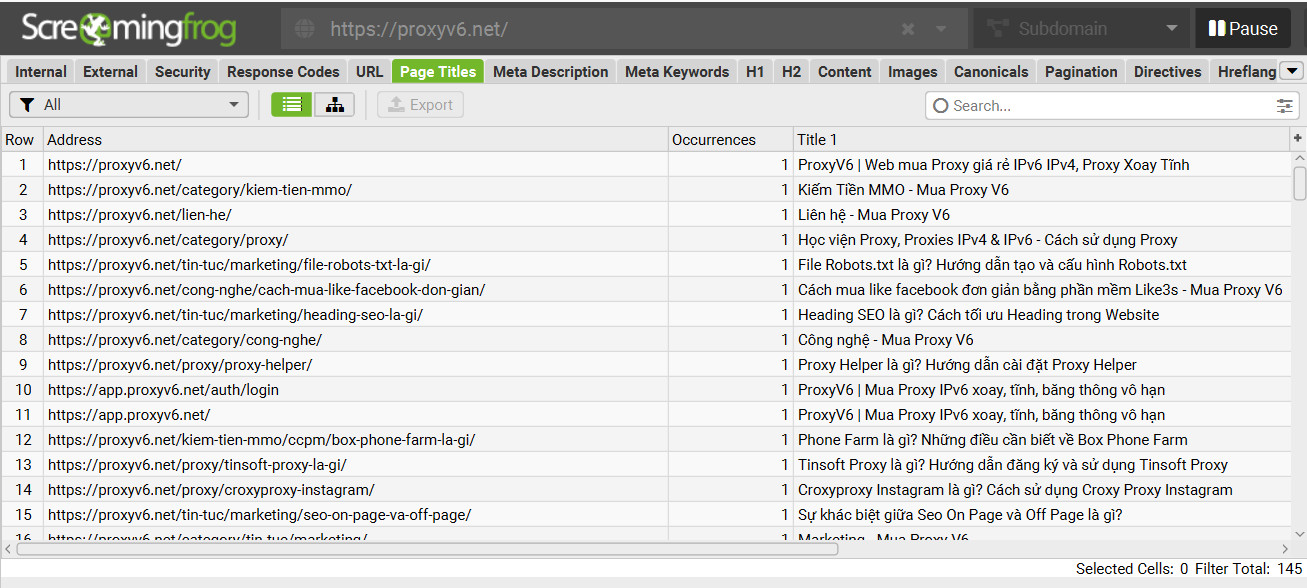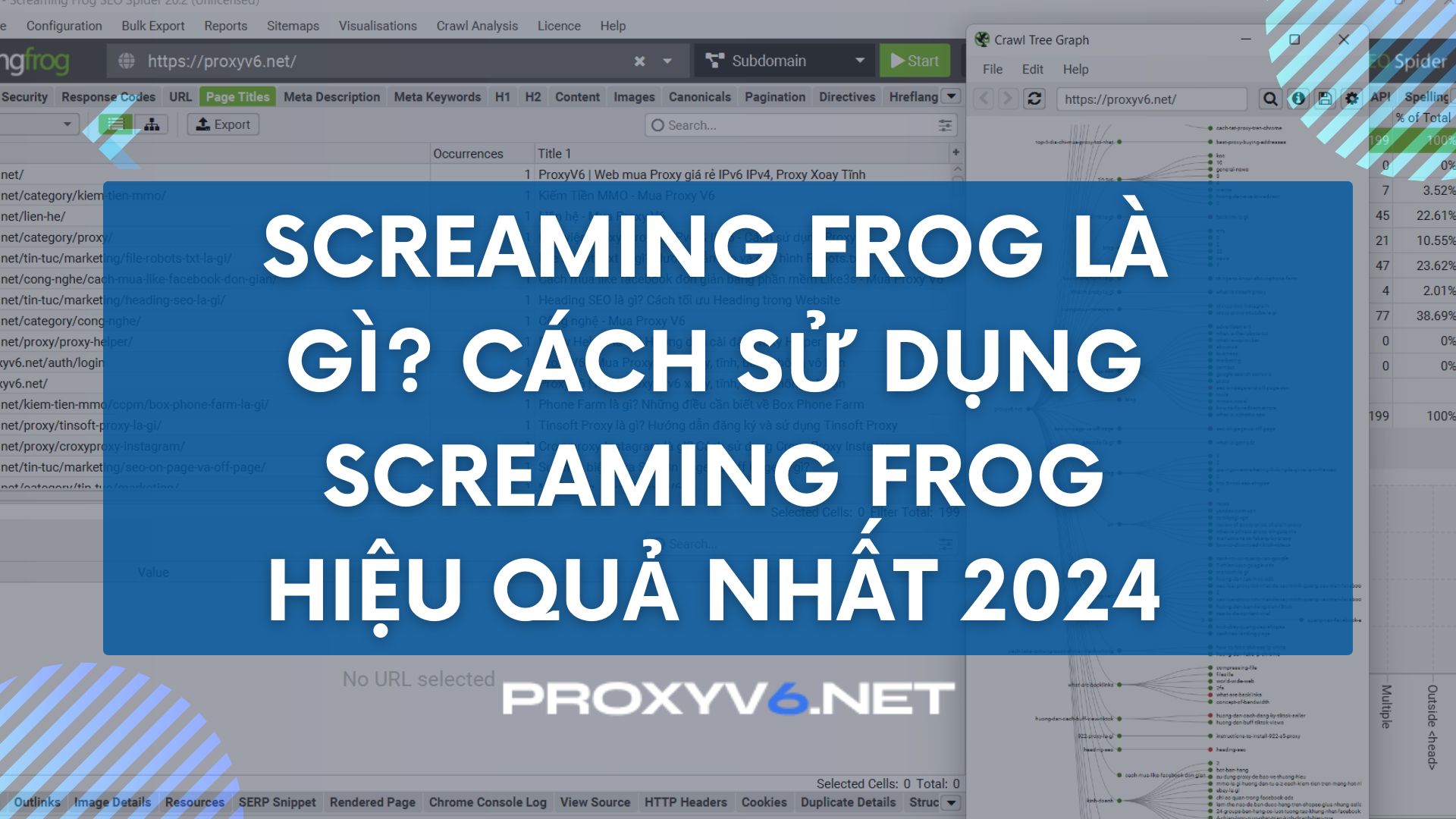In this article, ProxyV6 will guide you on how to use Screaming Frog effectively in 2024, helping your website climb to the top of search engines.
What is Screaming Frog?
Screaming Frog is a powerful SEO tool developed by Screaming Frog Ltd. This tool is mainly used to crawl websites, helping you analyze and check technical and content aspects in detail. Screaming Frog can scan through your websites in the same way search engines (like Google) do, identifying issues that could affect your SEO rankings.
How to download and install Screaming Frog
Before exploring the most useful features of Screaming Frog, ProxyV6 will guide you on how to download and install the Screaming Frog SEO Spider tool.
Instructions to download Screaming Frog SEO Spider
First, you need to download and install the Screaming Frog application on your computer. Here are the detailed steps:
Step 1: Access the Screaming Frog homepage
Click on the link below to navigate to the Screaming Frog interface: Screaming Frog SEO Spider.
Step 2: Download the application
Once on the homepage, click the “Download” button to download the application to your computer.
Step 3: Select the compatible operating system
Screaming Frog supports three operating systems: Windows, MAC, and Ubuntu. After selecting the operating system compatible with your computer, the application will automatically download.
Step 4: Install the application
- On Windows: Open the downloaded .exe file and follow the on-screen instructions to install.
- On MAC: Open the downloaded .dmg file, drag the Screaming Frog icon to the Applications folder to install.
- On Ubuntu: Open Terminal and use the following command to install:
sudo dpkg -i screamingfrogseospider_*_amd64.debEnsure that you have the necessary permissions on your computer to install the software. After installation, open the Screaming Frog application and start using its powerful features to analyze and optimize your website.
By following the above steps, you will easily download and install Screaming Frog SEO Spider, ready to fully exploit its useful features for SEO optimization of your website.
Installation guide for Screaming Frog after downloading
After downloading the Screaming Frog SEO Spider application to your computer, here are the detailed installation steps for each operating system.
On Windows
- Open the downloaded file: Find the .exe file you downloaded (usually in your Downloads folder) and double-click it to start the installation process.
- Run the installer: If prompted by User Account Control (UAC), click “Yes” to allow the program to make changes to your computer.
- Select the installation language: Choose the language you want to use during installation and click “OK”.
- Accept the terms of use: Read and accept the terms of use by clicking “I Agree”.
- Choose the installation folder: You can choose the default folder or click “Browse” to select a different folder, then click “Next”.
- Start the installation: Click “Install” to begin the installation process. Wait until the process is complete.
- Finish: Click “Finish” to end the installation process. You can choose “Launch Screaming Frog SEO Spider” to open the application immediately after installation.
On MacOS
- Open the downloaded file: Find the .dmg file you downloaded and double-click it to open.
- Drag to Applications: When the installation window opens, drag the Screaming Frog icon to the Applications folder.
- Open the application: Go to the Applications folder, find the Screaming Frog icon, and double-click it to open the application. You may need to confirm that you want to open an application downloaded from the Internet.
On Ubuntu
- Open Terminal: Open the Terminal window on Ubuntu.
- Navigate to the download folder: Use the
cdcommand to navigate to the folder containing the .deb file you downloaded. For example:
cd ~/Downloads
- Install Screaming Frog: Use the following command to install the .deb file:
sudo dpkg -i screamingfrogseospider_*_amd64.deb
- Fix dependencies: If you encounter dependency errors, use the following command to fix them:
sudo apt-get -f install
- Open the application: After installation, you can open Screaming Frog from the applications menu or by typing
screamingfrogseospiderin Terminal.
General note
Ensure that you have downloaded the correct version compatible with your operating system. After installation, check the configuration settings to ensure Screaming Frog works well with your system.
By following the above steps, you will easily install Screaming Frog and start using this powerful tool to optimize SEO for your website.
Why use Screaming Frog
Screaming Frog is an indispensable tool for SEO professionals, helping them analyze and optimize websites comprehensively. Using Screaming Frog, you will save time and effort in detecting and fixing technical issues on the website.
Detect technical errors
Screaming Frog helps you easily detect technical errors on the website such as broken links, redirect errors, and issues with page titles or meta descriptions. The tool scans the entire website and provides detailed reports on errors that need to be fixed to optimize SEO.

Optimize content structure
Screaming Frog supports you in checking and optimizing the content structure of the website, ensuring that all H1, H2 tags, and alt attributes of images are used correctly. This helps improve the visibility of the website on search engines.
Data analysis
With Screaming Frog, you can easily integrate with Google Analytics and Search Console to analyze traffic data and website performance. The tool provides deep insights into how users interact with the website, helping you make reasonable optimization decisions.
Create XML sitemap
Screaming Frog helps you quickly and easily create an XML sitemap. This XML sitemap is crucial in helping search engines understand and crawl your website, improving SEO rankings and increasing online visibility.
How to use Screaming Frog effectively in 2024
Screaming Frog is a powerful tool that helps you comprehensively and effectively optimize SEO. To maximize the potential of Screaming Frog in 2024, follow these steps and tips:
Response Codes – How to check response codes
To check the status of the URLs on your website, click the “Response Codes” tab. After the codes are returned, you can check the codes sequentially in the “Status Codes” section.
The HTTP status codes are decoded as follows:
- 200: OK – The request was successful. The meaning of success depends on the HTTP method used:
- GET: The data has been retrieved successfully.
- HEAD: The headers, entity are contained in the response.
- PUT or POST: The result of the action is returned.
- TRACE: The body of the response contains the request message received by the server.
- 301: “Moved Permanently” – The requested URL has been permanently changed to a new URL.
- 302: “Temporary Redirect” – This response means the URL of the requested resource has been temporarily changed.
- 404: “Not Found” – This status is very familiar, the server cannot find the request, simply accessing a post that does not exist in the system.
- 500: “Internal Server Error” – The URL on the web is experiencing some server-side issues.
- 503: “Service Unavailable” – The URL on the web is temporarily unavailable.
Fixing URL errors on your website
Errors found by “Response Codes” can be fixed as follows:
- Errors 301 and 302: Check the pages that your URL is redirected to. The destination page should be appropriate.
- Error 404: Check all the pages that return a 404 response code and adjust the redirect page. The destination page should have related content and topics.
- Errors 500, 503, or 5xx: Ensure that there are no issues with the website’s server.
Improving the quality of your website will significantly enhance and improve the website’s performance after you fix all the redirect errors on the pages.
URLs – Check website links
URL (Uniform Resource Locator) is the location of a website, page, or file on the Internet. Each URL is composed of several parts, and how you structure URLs will greatly impact the website’s security and SEO effectiveness.
Some notes on your website’s URL structure to enhance user experience and ease of use
- Keep it concise and clear: Short and clear URLs help users and search engines easily understand and access.
- Avoid complex characters: Avoid using special characters and unnecessary parameters in URLs to prevent confusion and difficulties in data collection.
- Unique and independent URL: Each URL should represent a unique page or resource on your website to avoid duplication and optimize SEO.
Paying attention to URL structure will help enhance user experience and improve SEO effectiveness for your website.
Checking and fixing technical errors
Screaming Frog will report detailed technical errors on the website, such as broken links, redirect errors, and issues with page titles or meta descriptions. Check these errors in tabs like “Response Codes”, “Page Titles”, and “Meta Descriptions”. Fix these errors to improve user experience and SEO performance.
Screaming Frog is a powerful and comprehensive SEO tool that helps SEO experts analyze and optimize websites and improve search engine rankings. With features like response code inspection, page title analysis, H1 tag inspection, image optimization, and XML sitemap generation, Screaming Frog makes it easy to detect and fix technical issues , optimize content and enhance user experience.
In 2024, using Screaming Frog effectively requires you to make the most of its features, from comprehensive data collection, to testing and fixing technical errors, to optimizing title tags and meta descriptions, to integrating with Google Analytics and generating XML sitemaps.
If you want to grasp more knowledge and tips about SEO, follow ProxyV6 to update the latest and most useful information. ProxyV6 will accompany you on the journey to optimize your website and achieve outstanding success in the field of SEO.







